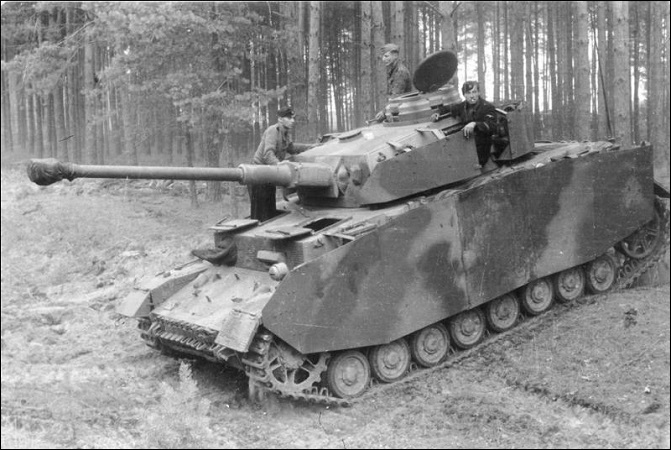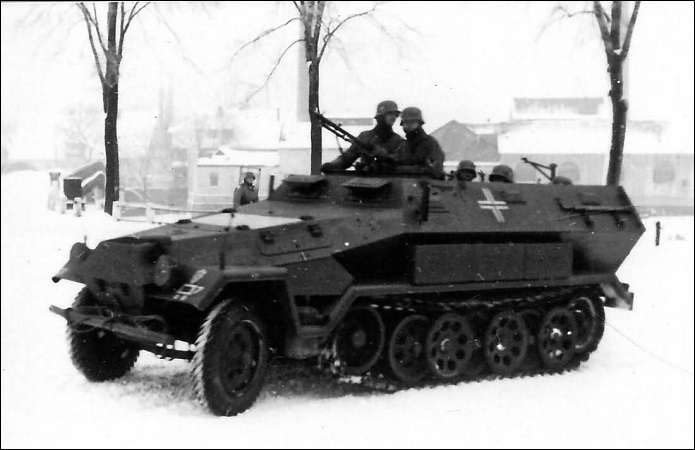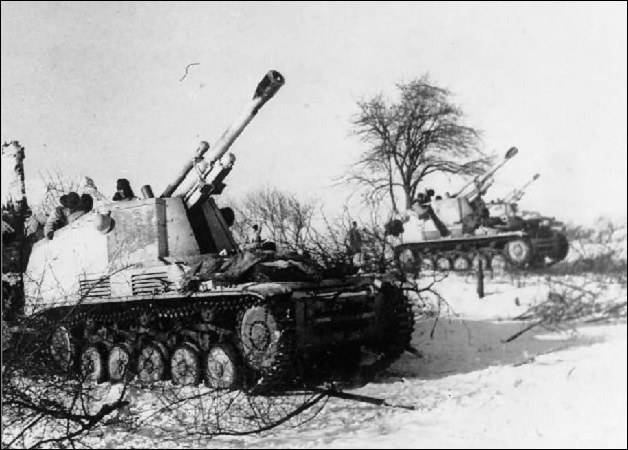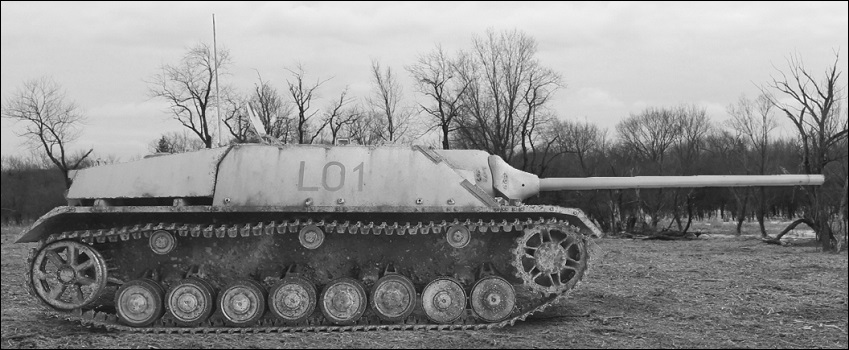By late 1943 the armored divisions of
the Allied armies—US,
British, Soviet—were remarkably
similar in their basic organization. (The Red Army called
its armored divisions
tank corps.)
Each had three tank battalions, three motorized or armored
infantry battalions and three field artillery battalions
plus assigned or attached antitank and antiaircraft units.
By comparison the late-war German panzer division seemed
quite different. But the differences were more apparent than
real, since the panzer division’s formal structure did not
reflect the manner in which it was organized for combat.
The German Army’s 1944-45 panzer
division used a streamlined version of the organization
introduced in mid-1943: a single panzer regiment with two
battalions; two panzer grenadier regiments, each with two
battalions; an artillery regiment with one self-propelled
and two towed battalions; an armored reconnaissance
battalion; an antitank battalion; a flak (antiaircraft)
battalion, a pioneer (combat engineer) battalion; plus the
usual divisional service units.
In the panzer regiment, one of the
battalions was to be equipped with Panzer V Panther tanks
(75mm L/70 gun) and the other with the Panzer IV (H or J
model; 75mm L/48 gun). This standardization did away with
the distinction between light and medium panzer sub-units;
all were now classed as medium. The battalions had a
headquarters company (eight tanks) and four panzer
companies, each with four platoons (five tanks each).
Counting two more tanks in the company headquarters
sections, this gave a battalion total of 96 tanks and,
counting eight more tanks in the regimental headquarters
section, a divisional total of 200 tanks.

The Panzer IV was the
German Army's most numerous medium tank, with nearly
9,000 produced between 1936 and 1945. Late-war models
were armed with the 75mm L/48 gun and often carried
spaced armor as a defense against hollow-charge antitank
rounds. (WW2 Weapons)
The panzer battalion also had a
flak (antiaircraft) platoon with three quadruple 20mm guns
mounted on unarmored halftracks, an armored pioneer (combat
engineer) platoon with armored halftracks, a maintenance
detachment and the battalion trains (transport and supply).
When specially authorized, the Panzer IV battalion could
also include a flamethrower platoon with five Panzer III
Flammpanzers.
It proved difficult, however, to
equip the Panzer IV battalions to this standard, and
practically impossible to do so with the Panzer V
battalions. It was therefore stipulated that the fourth
platoon in each panzer company could be deleted if
insufficient tanks were available, reducing company strength
to seventeen tanks. Additionally, one tank could be deleted
from each platoon, further reducing company strength to
fourteen tanks. In practice these reductions were almost
always necessary, particularity for the Panther battalions,
so that realistically divisional tank strength was on the
order of 50 Panthers and 67 Panzer IVs.
It was also stipulated that other
armored vehicles, such as the
Jagdpanzer
IV tank destroyer (75mm L/48 gun or 75mm L/70 gun) or
the Sturmgeschütz
III assault gun (75mm L/48 gun) could be substituted for
tanks if necessary. The usual procedure was to organize the
fourth company with these vehicles so that, for example, a
Panzer IV battalion would have 50 tanks and 17 tank
destroyers or assault guns. In some cases a complete
assault gun battalion
(31 assault guns) replaced a missing panzer battalion.
In the last year of the war such
expedients became more and more common. Though it reached
its wartime high in December 1944 tank, tank destroyer and
assault gun production declined thereafter, so that combat
losses could seldom be replaced on a one-for-one basis. Thus
the tank strength of the panzer divisions sank below even
the reduced establishments described above. In the last few
months of the war, the panzer divisions were lucky to have
fifty or sixty tanks on strength—a grim reality reflected by
the March 1945 panzer division reorganization, which cut one
of the two panzer battalions and mandated various other
personnel and equipment reductions. Few if any panzer
divisions were so reorganized before the war ended.
The panzer division’s two panzer
grenadier regiments each had two battalions. One battalion
was mounted on armored halftracks and the other three were
truck borne. Both
battalion types had a headquarters company, three rifle
companies and a heavy weapons company with a composite
flak/machine gun platoon, a 75mm infantry gun platoon and a
120mm mortar platoon. In the armored infantry battalion, the
infantry gun and flak MG/platoon were self-propelled (SPW
251/10 halftrack and SPW 251/17 respectively).

The SPW 251/1 was
the German Army's basic armored halftrack. It
could carry a panzer grenadier squad (10 men
with two light machine guns), and it was also
used as a prime mover for antitank guns and
infantry guns. (Bundesarchiv)
Each panzer grenadier regiment had
a heavy (150mm) infantry gun company that could be either
unarmored halftrack towed, armored halftrack towed or
armored self-propelled (SzKfd 138/1). The first two company
types had four guns; the latter had six. Also at the
regimental level was a mechanized light flak (antiaircraft)
company with eight single and two quadruple 20mm AA guns
mounted on unarmored halftracks. The battalions had no
antitank guns, reliance being placed on the Panzerschreck
(bazooka) and the Panzerfaust one-shot disposable antitank
weapon, both of which were widely issued.
While the armored infantry
battalion was better able to fight in cooperation with
tanks, the three motorized battalions gave the division
more defensive staying power—and by 1944 the German Army was
fighting mainly on the defensive. But vehicle shortages
affected the panzer grenadiers just as much as they did the
panzer regiment. Trucks and armored halftracks were usually
in short supply, and often the motorized battalions had to
make do with bicycles instead. Since, however, the days of
the slashing blitzkrieg attack were long past by 1944 this
was less of a disadvantage than it seemed.
The panzer division's artillery
component was embodied in a regiment of three battalions.
The first battalion was a composite self-propelled unit with
two light batteries (each with 6 x 105mm howitzer) and one
heavy battery (6 x 150mm howitzer). The second battalion had
three batteries (each with 4 x 105mm howitzer, halftrack
towed) and the third battalion was a composite unit with two
heavy howitzer batteries (each with 4 x 150mm howitzer,
halftrack towed) and one gun battery (4 x 105mm gun,
halftrack towed). There were many deviations from this
standard, however. Some divisions were partly equipped with
captured weapons; the heavy artillery battalion of the crack
Panzer Lehr Division, for example, was equipped with
halftrack-towed Russian 152mm howitzers.

The panzer artillery
regiment included two batteries with six Sd.Kfz.
124 Wespe (Wasp) self-propelled howitzers
each. Introduced in 1943, the
Wespe
mounted a 105mm howitzer on the chassis of the
obsolete Panzer II light tank. (Bundesarchiv)
Unlike the US armored division, the
panzer division had an organic antitank battalion. This unit
had two self-propelled companies and one towed company.
Ideally, the former were to be equipped with the
Jagdpanzer
IV tank destroyer, but the lighter
Jagdpanzer
38 (75mm L/48 gun) or the
Sturmgeschütz III or
IV
assault gun could be and often were substituted. In early
1944 each company had fourteen tank destroyers in three
platoons (four tank destroyers each) plus two in the
headquarters section. Counting three more in the battalion
headquarters company, the battalion had 31 tank destroyers.
The third company had three platoons, each with four 75mm
antitank guns, halftrack towed. In late 1944, however, one
tank destroyer was deleted from each self-propelled platoon,
one from the company headquarters sections and two from the
battalion headquarters section, leaving the battalion with
21 tank destroyers. But even this reduced establishment was
hard to maintain in the last phase of the war. Many
battalions were only two companies strong (one
self-propelled, one towed), or had to be equipped with
obsolescent models like the Marder tank destroyer, or had
only towed antitank guns.

The
Jagdpanzer IV tank destroyer was based on the
chassis of the Panzer IV tank and was armed with
the same 75mm L/70 gun as the Panther tank. In
general design it was similar to the
Sturmgeschütz III assault gun.
(World War Photos)
The panzer division’s organization was
rounded out by an
armored reconnaissance battalion,
a flak battalion and a panzer pioneer (combat engineer)
battalion. The reconnaissance battalion was a powerful unit
equipped with a mix of wheeled and halftrack armored cars.
Ideally, the whole battalion was to be equipped with armored
halftracks, but often it was necessary to equip one or two
of the reconnaissance companies with the Volkswagen light
field car instead. The same applied to the panzer pioneer
battalion, which was supposed to have one company mounted on
armored halftracks and two equipped for trucks. Sometimes it
was necessary to partly or fully equip the armored company
with trucks. The flak battalion had eight 88mm antiaircraft
guns, halftrack towed, that could also be employed as
antitank guns, plus numerous towed and self-propelled 20mm
guns.
Though the panzer division appeared
to have a rigid regimental/battalion structure, its
organization for combat was based on the German Army’s
well-tried Kampfgruppe (battle group) concept:
Battalions, companies and even platoons were cross-attached
among the panzer and panzer grenadier regiments to create
mission-oriented battle groups. For example, the armored
panzer grenadier battalion, an armored platoon from the
panzer pioneer regiment, and a self-propelled light flak
platoon might be attached to the panzer regiment to form an
armored strike force. In return, the panzer regiment might
give up one of its battalions to a panzer grenadier
regiment. The procedure could also be carried out at the
battalion level. The armored reconnaissance battalion,
already well armed, might be reinforced by a company from
the panzer regiment or a self-propelled tank destroyer
platoon from the antitank battalion. A motorized panzer
grenadier battalion might gain an 88mm flak battery or a
tank destroyer company, and so on.
The ability to form such battle
groups explains why even late in the war, despite losses and
shortages, the German Army was able to fight on. Often a
depleted panzer division could be bolstered up by taking
odds and ends of other units under command: a couple of
infantry companies, a nondivisional heavy artillery
battalion, rear-echelon support troops as individual
reinforcements or formed into ad hoc platoons and companies,
etc.
Though in the long run these expedients were futile, they
undoubtedly prolonged the war.
See Also
Panzer
Divisions 1935-41 and Panzer
Divisions 1942-43
● ● ●